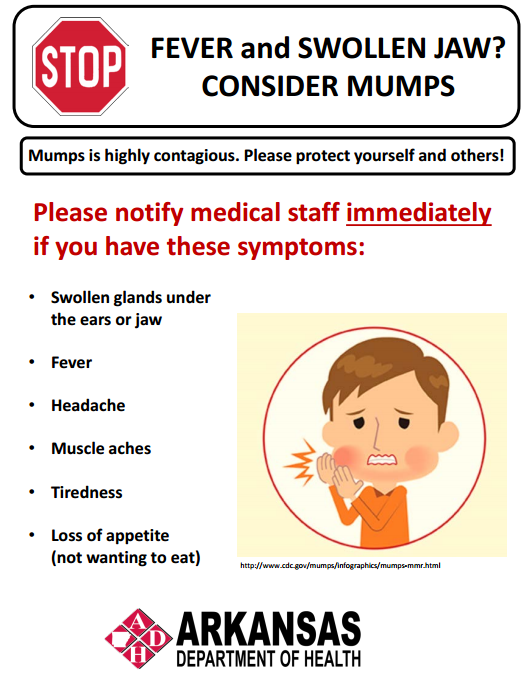The mumps outbreaks in Arkansas and Oklahoma continue to grow in number of cases as investigations continue in the neighboring states.
In Oklahoma, The Oklahoma State Department of Health puts the outbreak total at 70 cases as of Monday. 68 cases have been reported in Garfield County and two in Kay County. The vaccination status of those infected show that eight out of 10 patients were vaccinated against mumps, while the other 20 percent were either not vaccinated or their status is unknown.

Two dozen additional cases are under investigation.
The suspected and lab confirmed case count in Arkansas, as of Monday, has reached 476 in three counties (Benton, Washington, and Madison). There are currently 13 workplaces and 3 school districts (32 schools) still impacted.
We recently reported that approximately two-thirds of the cases have been reported in the Marshallese community in Springdale.
Mumps is an infection caused by the mumps virus. Symptoms of mumps usually include swelling on one or both sides of the face, tenderness of the salivary glands (the cheek and jaw area), slight fever, headache, general aches, and muscle pain.
The parotid salivary glands (located within the cheek, near the jaw line and below the ears) are most frequently affected. This swelling of the parotid glands is commonly called “parotitis.” Swelling of the testicles (orchitis) occurs in 20 to 30 percent of males if infection occurs after puberty.
In rare cases, mumps can cause meningitis (swelling of the brain and spinal cord) or inflammation of the brain itself, known as encephalitis. Mumps infection during the first three months of pregnancy may be linked to miscarriage.
The mumps virus is found in the saliva and fluid in the nose and throat and spreads from person-to-person by coughing, sneezing, or by direct contract with nose and throat secretions. Infected individuals can transmit the virus two days before symptoms appear and up to five days after symptoms begin. Symptoms of mumps can appear 12 to 25 days after exposure, but usually begin within 16 to 18 days.
The MMR vaccine is safe and effective. According to the CDC, two doses of mumps vaccine are 88% (range 66% to 95%) effective at preventing the disease; one dose is 78% range (49% to 91%) effective.
In addition to vaccination, other preventive measures that can be taken to prevent the disease include: Do not share food, drinks, utensils or other personal items that may contain saliva; wash your hands frequently with soap and water, or use an alcohol-based hand rub if soap and water are not available; cover your nose and mouth with a tissue if you sneeze or cough, and discard the tissue after you use it. If a tissue is not available, sneeze or cough into your upper sleeve or elbow, not your hands; clean and disinfect objects and surfaces that may be contaminated with germs and people with the mumps should stay home, and away from public places for five days after the onset of symptoms and limit contact with others in their household.
Related:
- Egypt reports 10 human H5N1 avian influenza cases in first nine months of 2016
- Niger Rift Valley fever update: 90 cases, 28 deaths
- Haiti, cholera and the aftermath of Hurricane Matthew


2 thoughts on “Mumps outbreaks in Arkansas and Oklahoma: What is the latest?”